A Stroll through the University’s History
Attraction
The university city of Lund
Stroll
about 1 hour
One way to experience the university city of Lund is to stroll to the places that initiated
Lund’s academic history in the 14th hundreds and the places where learning took place until
the 19th hundreds. Since then, the university has grown to occupy the northeastern area of
Lund and also to include campuses in Helsingborg and Malmö.
 The University building was inagurated August 27th, 1882, by King Oscar II
The University building was inagurated August 27th, 1882, by King Oscar II
This stroll through the history of the University of Lund describes how its academic activities have taken place at the sites indicated on the map below.
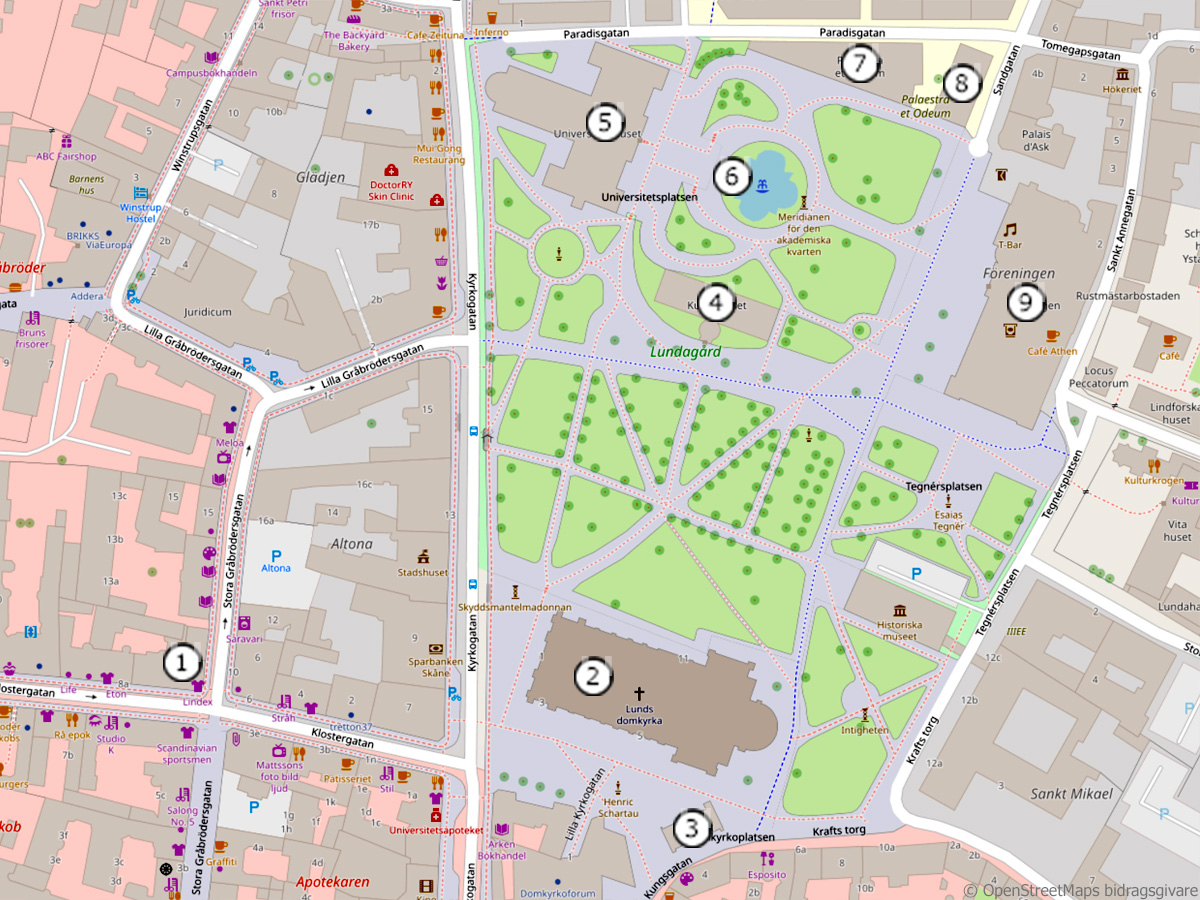 Map that shows the sites of Lund’s academic history.
Map that shows the sites of Lund’s academic history.
1) Grayfriers Cloister
The first School of Higher Education in Scandinavia
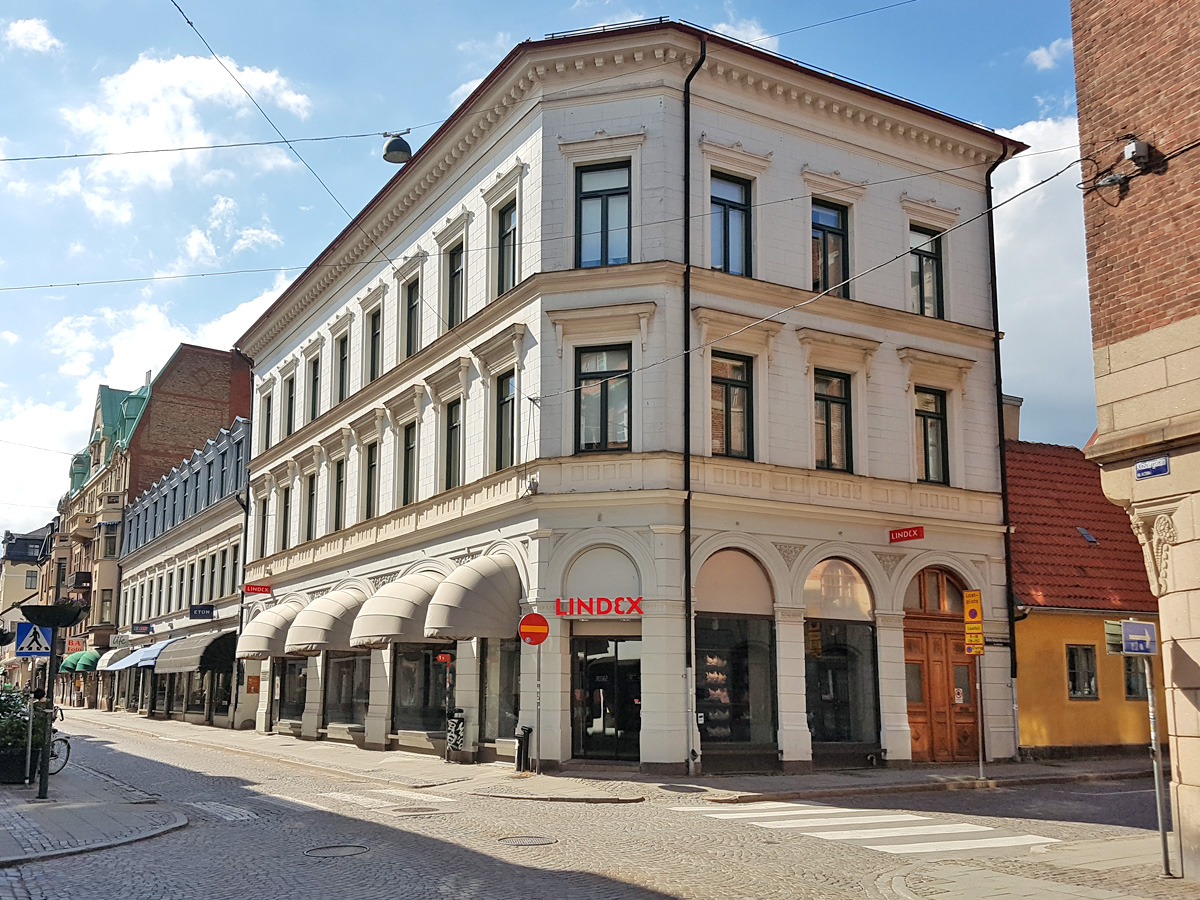 The location of Grayfriers Cloister during the Middle Ages.
Lund was the first city in Scandinavia that offered an academic education, which began at the
Franciscan religious center Saint Catherine’s, the so called Grayfriers, located on
Klostergatan ("Cloister Street").
The location of Grayfriers Cloister during the Middle Ages.
Lund was the first city in Scandinavia that offered an academic education, which began at the
Franciscan religious center Saint Catherine’s, the so called Grayfriers, located on
Klostergatan ("Cloister Street").
In 1238, the Franciscan friars arrived in Lund. Their church, which occupied one of the four sides in their cloister, or convent as the mendicants called it, was consecrated in 1276. In 1419, Archbishop Peder Lykke, whose seat was in Lund, suggested that a school of higher education, a so called studium generale, be created at Grayfriars. Pope Martin V approved the plans in 1425, but not until 1438 did the education start.
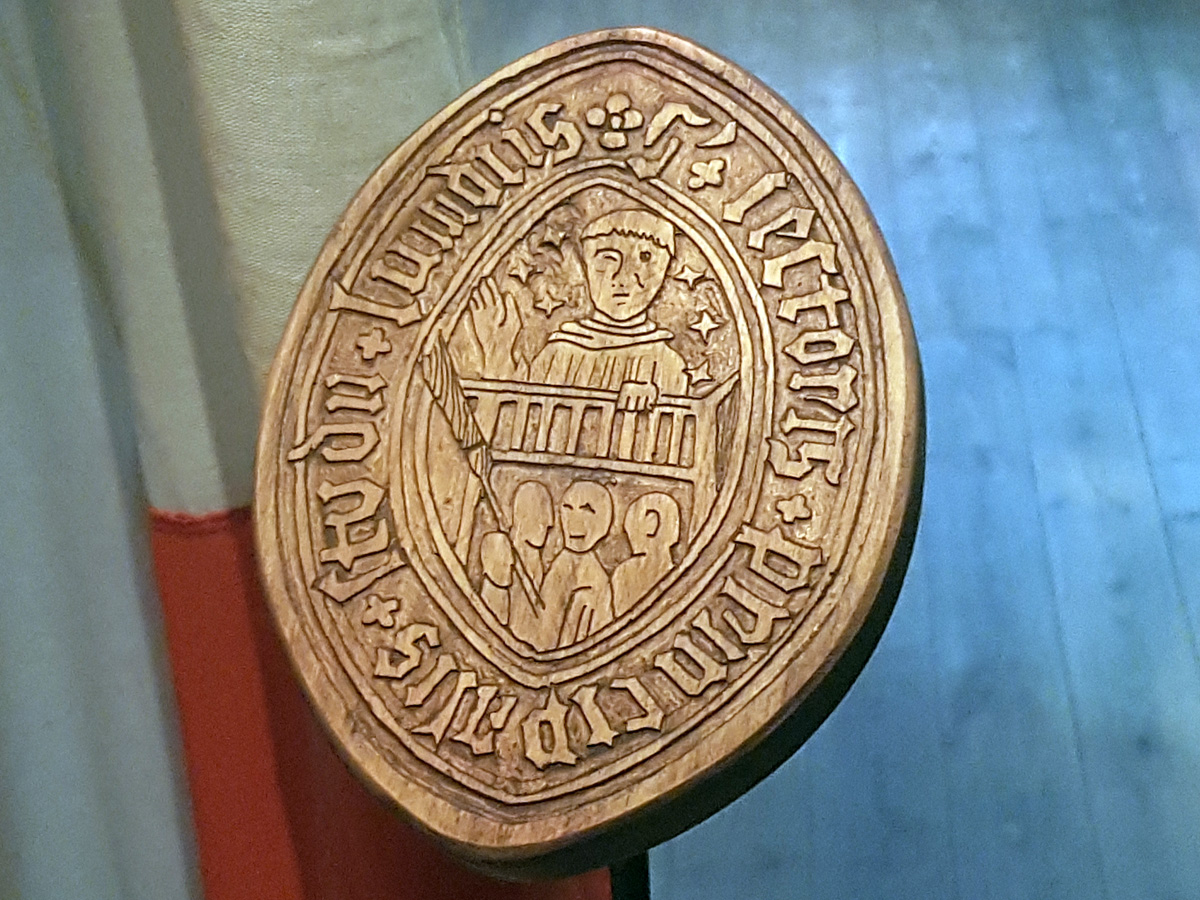 Seal inscribed S' lectoris principalis studii lundensis, in rough translation, "Seal of the
Head of Lund’s School of Higher Education."
To prepare for studium generale, students were expected to have learned the basics at a
cathedral school. The foundation of Lund’s cathedral school likely occurred in connection to
King Knut the Holy’s letter of gift of May 21th, 1085, which also financed the construction of
Lund’s cathedral and the institution of its chapter.
Seal inscribed S' lectoris principalis studii lundensis, in rough translation, "Seal of the
Head of Lund’s School of Higher Education."
To prepare for studium generale, students were expected to have learned the basics at a
cathedral school. The foundation of Lund’s cathedral school likely occurred in connection to
King Knut the Holy’s letter of gift of May 21th, 1085, which also financed the construction of
Lund’s cathedral and the institution of its chapter.
At studium generale, a student would earn a degree of baccalaureus, today’s B.A. The studies consisted of lectures, repetition of lectures, and disputations. During the lectures, the Bible was read and commented upon as well as Petrus Lombardus’ (d. ca 1160) work Libri quattuor sententiarum. It was used as a handbook of dogma at all European schools of theology. The teachers were called "lectors." Among them was a lector principalis, e.g. the head teacher, which meant that the school included more than one.
After the Reformation of the Danish church, October 30th, 1536, the Franciscans and all serving within the Roman Catholic church were expelled from Lund, and all Lund’s churches, save the Cathedral and the Cloister Church, were razed. Thus, academic education at Grayfriars ceased. First after 132 years was academic education resumed in Lund.
Founding of Lund’s University
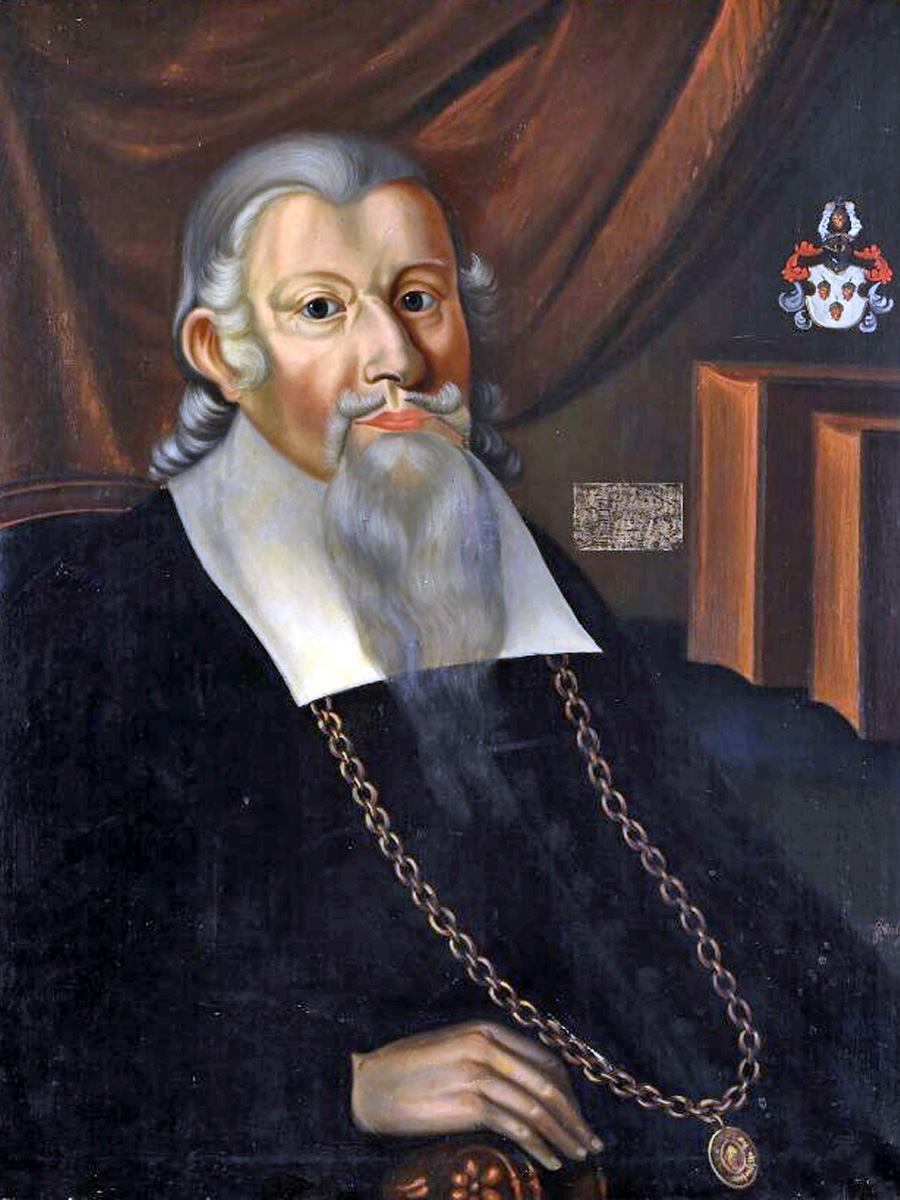 Bishop Peder Winstrup.
In the Peace of Roskilde, February 26th, 1658, between Sweden and Denmark, Denmark ceded
Scania to Sweden. So Lund and Scania became Swedish after belonging to Denmark for nearly 700
years. A week later, March 5th, 1658, when the Swedish King Charles X arrived in Helsingborg,
the Bishop of Lund, Peder Winstrup, as representative of Scanian clergy, welcomed him with a
speech in Latin.
Bishop Peder Winstrup.
In the Peace of Roskilde, February 26th, 1658, between Sweden and Denmark, Denmark ceded
Scania to Sweden. So Lund and Scania became Swedish after belonging to Denmark for nearly 700
years. A week later, March 5th, 1658, when the Swedish King Charles X arrived in Helsingborg,
the Bishop of Lund, Peder Winstrup, as representative of Scanian clergy, welcomed him with a
speech in Latin.
Peder Winstrup's meeting with Charles X
Two weeks later, Charles X visited Peder Winstrup in Lund for two days, discussing how Scania best be incorporated to the rest of Sweden. Peder Winstrup suggested that establishing an academy, e.g. a university, in Lund was most important, which Charles X considered a good suggestion. However, the Swedish provinces’ four estates (nobility, clergy, burgers, and farmers) did not see the establishment of an academy in Lund as something positive, and the regency government of Charles XI (a minor) later denied the proposal.
 Sweden’s Chancellor Magnus Gabriel De la Gardie.
Sweden’s Chancellor Magnus Gabriel De la Gardie.
Bernhard Oelreich takes takes action
Bernhard Oelreich, rector of the parishes of Åsum och Skepparslöv and the representative of the Scanian clergy estate at the 1664 parliament in Stockholm, became the widowed Queen Hedvig Eleonora’s court preacher September 15th, 1664. Not much is recorded of Bernhard Oelreich’s discussions with the widowed Queen, but in 1665 he met with Chancellor Magnus Gabriel De la Gardie, a confidant of Hedvig Eleonora and the most powerful person in the Regency. Oelreich convinced De La Gardie of the benefits of an academy in Lund, and De la Gardie forced the proposal through parliament. A year later, December 19th, 1666, Queen Hedvig Eleonora and the Regency government signed the proposal of the establishment of Lund’s University.
Somewhat more than a year later, January 28th, 1668, the University of Lund was inagurated. From its inception, it included four faculties, namely theology, law, medicine, and philosophy. The Faculty of Philosophy, however, was broadly defined and encompassed subjects that today would correspond to the humanities, natural and social sciences, and economics.
2) University Lectures in Lund’s Cathedral
 Lund’s Cathedral.
In the beginning, the new academy in Lund didn’t have buildings of its own; instead, it used
the Lund’s Cathedra. Lectures were held in the cathedral chancel area, hidden behind a
templon - a wall separating the chancel from the nave - and two side chapels, located along
the southern transept, facing the Cathedral Plaza. After the reformation in 1536 of the Danish
church, the side chapels were no longer used for liturgical purposes.
Lund’s Cathedral.
In the beginning, the new academy in Lund didn’t have buildings of its own; instead, it used
the Lund’s Cathedra. Lectures were held in the cathedral chancel area, hidden behind a
templon - a wall separating the chancel from the nave - and two side chapels, located along
the southern transept, facing the Cathedral Plaza. After the reformation in 1536 of the Danish
church, the side chapels were no longer used for liturgical purposes.
The the theological faculty used the chancel, while the side chapels were used by the medical and juridical faculties. The University’s Consistorium, or governing board, used the Cathedral for its meetings, too. The dedication of the university January 28th, 1668, was held in the Cathedral, which at the time had no heating. So in the winter the church was often very cold.
3) Liberiet - “The Old Academy”
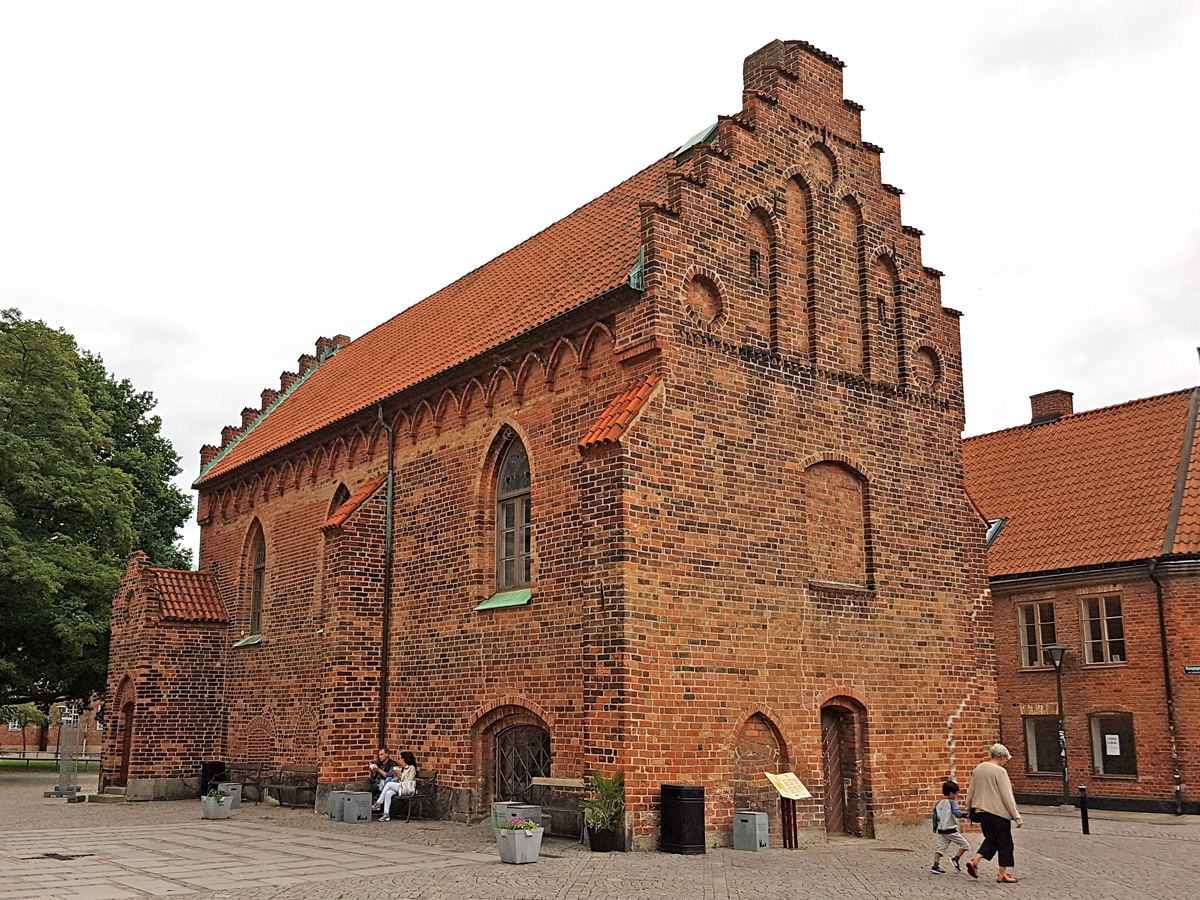 Liberiet.
The Faculty of Philosophy used Liberiet for its educational purposes. Lund’s University used
Liberiet for a long time, and when it later acquired the “King’s House,” Liberiet was renamed
“The Old Academy.” Liberiet was built during the second half of the 14th hundreds to function
as the Cathedral Chapter’s library. Previously, this library was located in the Cathedral’s
southern sacristy, but the advent of printing caused the number of books to grow rapidly,
requiring a larger space.
Liberiet.
The Faculty of Philosophy used Liberiet for its educational purposes. Lund’s University used
Liberiet for a long time, and when it later acquired the “King’s House,” Liberiet was renamed
“The Old Academy.” Liberiet was built during the second half of the 14th hundreds to function
as the Cathedral Chapter’s library. Previously, this library was located in the Cathedral’s
southern sacristy, but the advent of printing caused the number of books to grow rapidly,
requiring a larger space.
In 1765, Liberiet’s upper floor was remodeled and turned into a fencing hall, where “the father of Swedish gymnastics,” Per Henrik Ling taught his students 1805-1813. In 1843, the Cathedral Architect Carl Georg Brunius was asked to renovate Liberiet, which then was in bad condition. The fencing hall was turned into a practice hall for the academic chamber orchestra, which remained there until 1883, when they moved to a new space.
The Scanian War
From its inception, the university attracted many students. During its first year, the university had 32 staff members, half of whom were professors, and during its first eight years over 800 students were enrolled. However, the university only functioned for eight years. In September 1675, Denmark declared war against Sweden, starting the so called Scanian war. Danish troops invaded all of Scania June 29th, 1675. The University reacted quickly and moved valuables to the fortified Malmöhus Castle and then ceased its activities. The Scanian War lasted until September 26th, 1679, when the warring parties signed a declaration of peace. However, King Charles XI hesitated to let the university resume its activity after the war. First 1682, did he give his permission for the university to open again.
4) ”The King’s House” — the University’s First Own House
In 1688, King Charles XI donated the The King’s House and Lundagård (the area between the Cathedral and the King’s House) to the university; whereby it acquired a house of its own. However, the house was in bad condition, not least from the damage caused by a Danish troupe that burned large areas of Lund August 11th, 1678. First in 1695 did the University receive sufficient funds to complete the renovation of the house, enabling it to continue activities by the end of 1696.
The Lundagård fortress
 ”The King’s House”.
From the 970s with the foundation of Lund and during most of the 1000s, Lundagård fortress was
part of the King’s property, a large area. During the Middle Ages until the Reformation 1536,
it was the seat of the Archbishop of Lund, the ecclesiastical head of the Nordic countries.
After the reformation, the Danish Crown appropriated the Cathedral Chapter’s property and
created the province of Lundagård to maintain the Archbishop’s fortress. The King’s House was
built between 1578 and 1584 intended as residence for the province head and for the Danish
King during visits. For example, in 1584, King Fredrick II stayed there with his son, who was
going to be celebrated as the future King Christian IV by Scania’s governing meeting.
”The King’s House”.
From the 970s with the foundation of Lund and during most of the 1000s, Lundagård fortress was
part of the King’s property, a large area. During the Middle Ages until the Reformation 1536,
it was the seat of the Archbishop of Lund, the ecclesiastical head of the Nordic countries.
After the reformation, the Danish Crown appropriated the Cathedral Chapter’s property and
created the province of Lundagård to maintain the Archbishop’s fortress. The King’s House was
built between 1578 and 1584 intended as residence for the province head and for the Danish
King during visits. For example, in 1584, King Fredrick II stayed there with his son, who was
going to be celebrated as the future King Christian IV by Scania’s governing meeting.
Bishop's residence for Peder Winstrup
In 1660, Bishop Peder Winstrup bought the King’s House, making it his family home. After the inaugural ceremony of Lund’s University January 28th, 1668, Peder Winstrup hosted a sumptuous dinner for the attending guests. The ceremony ended with lengthy fireworks that succeeded in showing the King’s monogram light up the dark winter night. Peder Winstrup died 1679, and in 1680 the Crown appropriated The King’s House and Lundagård in connection to Charles XI’s “reduction” policy, during which all property owned by the nobility that previously belonged to the Crown, again became Crown property. Finally in 1688, the King’s House was donated to Lund’s University.
 The park Lundagård with the King's house in the background.
The park Lundagård with the King's house in the background.
The King's house as a university building
In the beginning, the King’s House had only two floors. The upper floor’s western part held the room of the constitorium and a large auditorium with benches and two lecterns, intended as the site for disputations. In the same area of the house, a theater of anatomy was built 1736. The upper floor’s eastern part held the university library. When Charles XII ruled Sweden from Lund, 1716-1718, he often visited the library, using it as his reading room. The first floor’s western part held two auditoriums, the larger of which corresponds to today’s Caroline Auditorium. A couple of smaller rooms on the first floor were designated as the university bookstore.
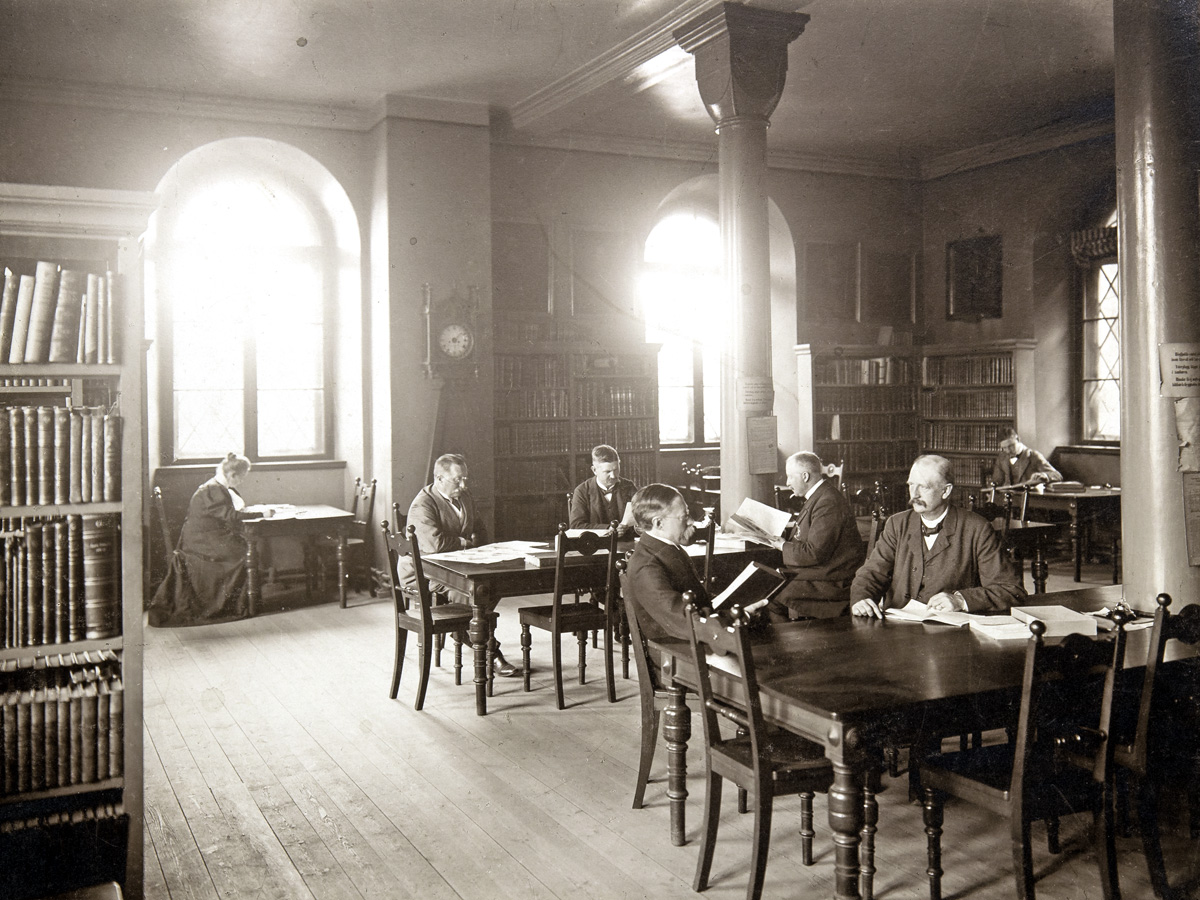 The University Library in the King’s House circa 1900.
The University Library in the King’s House circa 1900.
The university library
At its inception, the University did not possess a library of its own. Instead, Peder Winstrup’s private collection of books acted as library. In 1671, the university appropriated the Cathedral Chapter’s library, which had been housed in Liberiet since the 14th hundreds. It comprised about 300-400 books and 13 manuscripts.
In 1684, Charles XI donated the Gripenhielm collection with circa 6,000 books to the university library. Edmund Gripenhielm had worked as tutor to Charles XI, and as Inspector of the Royal Library he travelled widely in Europe acquiring books. Many of these books were precious, and many had been plundered during the Thirty Years’ War from libraries in, for example, Poland, Austria, Germany, and Denmark.
The King's House become too small for the university
In 1698, King Karl XII introduced a “duty system”, which means that a copy of everything printed in Sweden must be delivered to Lund University library, among other libraries. This meant that the collections grew rapidly, and in 1802, the first of two planned wing buildings was built on the east side of the King's House. The building was called the "New Academy" and became the residence for the university management and its consistory. The building is better known as "Kuggis", which refers to the fact that you risked failing the entrance exam to the university that was introduced in 1831 and hold in that building.
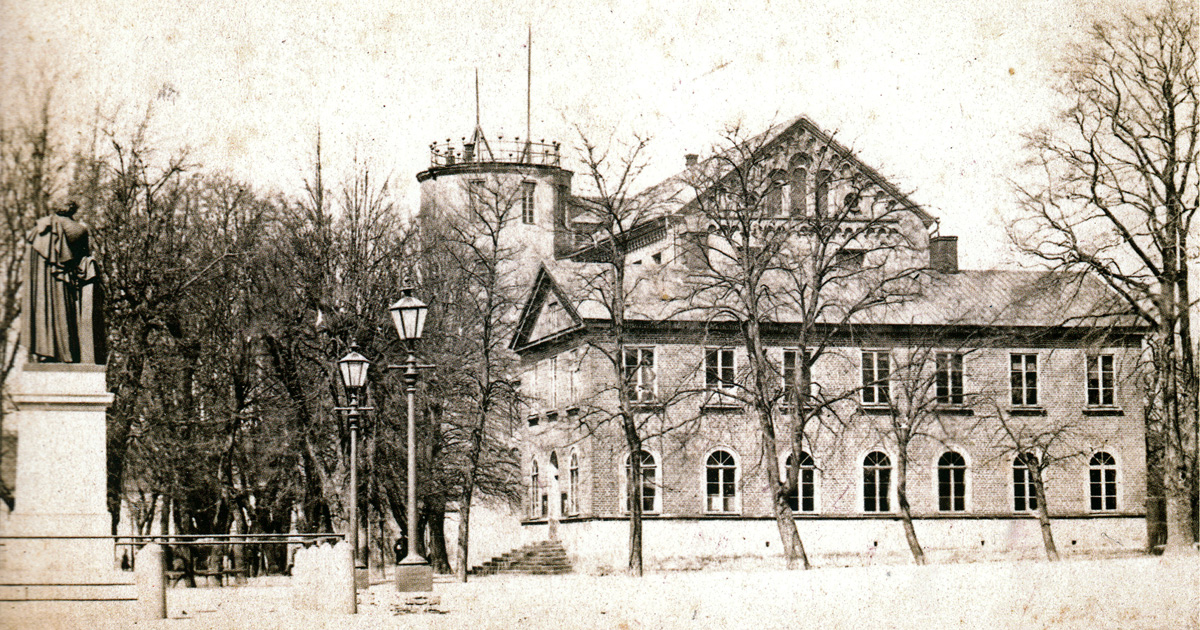 The "New Academy" building, better known as "Kuggis", and the King's House behind, photograph
taken in the 1860s.
The "New Academy" building, better known as "Kuggis", and the King's House behind, photograph
taken in the 1860s.
Between 1837 and 1839, the King's House was extended with a third floor. From 1884, when the new University Main Building was inaugurated and taken into use, the entire King's House and the "New Academy" building were used as a university library. The second planned wing was never built, and in 1897 the "New Academy" building was demolished to make room for a new bigger library building. Instead, in 1907 the University Library got a new, larger building at Helgonabacken (The Saints’ Hill), where it still is today.
University management returns to the King's House
In November 2017, the University Main Building had to be evacuated when moisture and mold were found and there were problems with the ventilation system. The university management moved to temporary accommodation while waiting for the King's House to be renovated. In January 2024, when the renovation was completed, the University Management moved into the King's House, which took over the role as the residence for the University Management, which the University Main Building had previously. Unfortunately, the King's House is not open to the public.
5) The University Building
The University Building was constructed 1878-1882 and inagurated by King Oscar II August 27th, 1882. Its architect, Helgo Zettervall, was also in charge of the Cathedral’s restoration. The University Building’s architecture is inspired by Greek antiquity both in- and outside. Above the main entrance at the University Plaza is an inscription “Regia Academia Carolina” which means “The Royal Caroline Academy”, which was the original name of the University, named after the Swedish king Karl X.
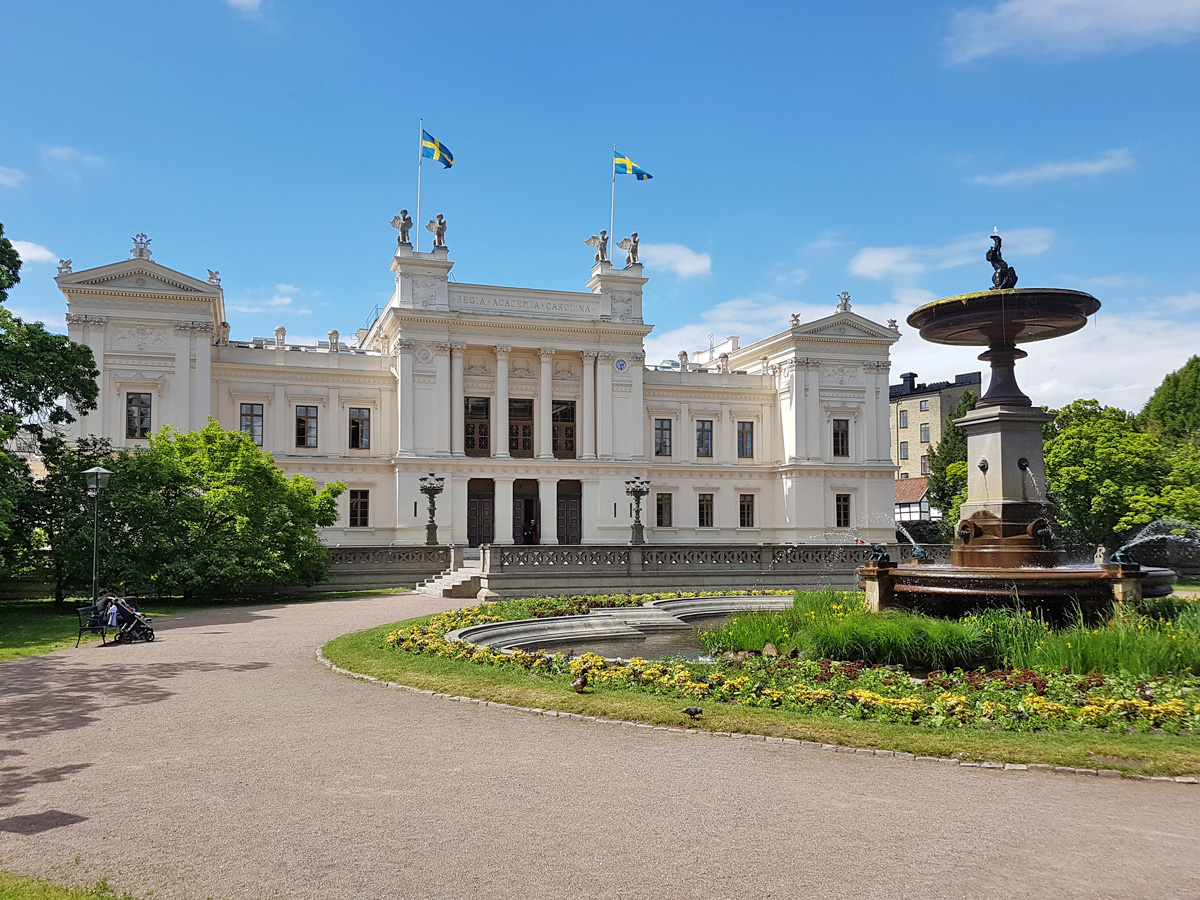 The University Building.
In the beginning, four large statues of women, the so called “faculty madams,” stood next to
the three doors at the main entrance. They represented the university’s four faculties and
each carried a sign with the inscriptions Juris Scientia, Theologia, Philosophia och Medicina.
Soon, the statues developed cracks because they and other sculptures were made of cement; thus,
they were removed in 1902. The four original sphinxes on the roof were removed 1959, They were
replaced with new sphinxes 1993 which were removed November 2, 2021. The current sphinxes were
placed at the University Building in beginning of October 2024.
The University Building.
In the beginning, four large statues of women, the so called “faculty madams,” stood next to
the three doors at the main entrance. They represented the university’s four faculties and
each carried a sign with the inscriptions Juris Scientia, Theologia, Philosophia och Medicina.
Soon, the statues developed cracks because they and other sculptures were made of cement; thus,
they were removed in 1902. The four original sphinxes on the roof were removed 1959, They were
replaced with new sphinxes 1993 which were removed November 2, 2021. The current sphinxes were
placed at the University Building in beginning of October 2024.
Much of the University Building has stayed unchanged since it was built, but the function of several rooms are diffrent, and modern toilets were installed in the basement. In the beginning, the managerial office was located to the left of the entrance in the southern part of the ground floor. Behind that room, offices of government and administration were located. You reached these rooms through the entrance on the House’s southern side. All students had to enter this way when they matriculated.
The ground floor also included rooms for the faculties, for meetings, and for examinations. The second floor held classrooms, and the top floor included an art gallery. At first, the university’s historical and archeological collections were located in the so called “pillar hall” in the basement. However, in 1907, concurrent with building the new university library, these collections returned to the King’s House where they had access to all of the ground floor.
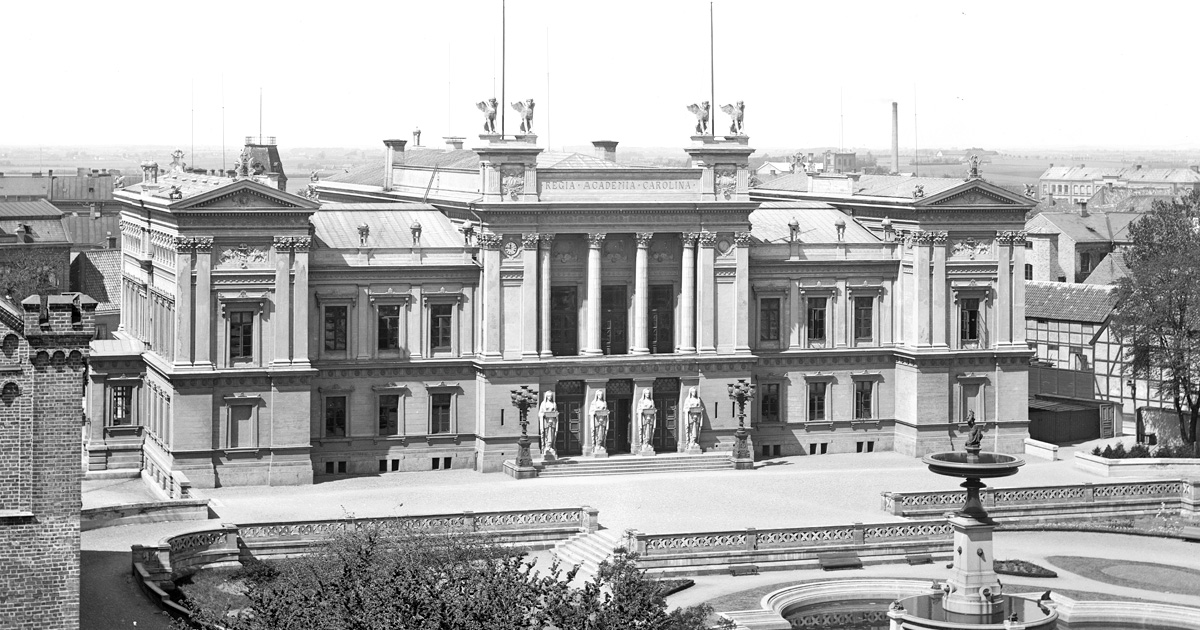 The University Building before 1897 when the four faculty madams still stood at the entrance.
The University Building before 1897 when the four faculty madams still stood at the entrance.
At the present, the University Main Building is closed for renovation. The plan is to use it as a Visitors’ Center for the university when it opens again. Before it closed, it was the work place for the university management, and the Vice-Chancellor’s office was located at the ground floor in the northern part with windows towards the University Plaza.
6) University Plaza
The area between the University Building and The King’s House is called the University Plaza. During the Middle Ages, the site covered the Archbishop’s “apple yard,” that is, his orchard. From the beginning of the 17th hundreds and until the 1860s, the site was used as a botanical garden. The fountain in the center of the Plaza with its four so called “faculty frogs” is also designed by the Cathedral architect Helgo Zettervall and was completed in 1889.
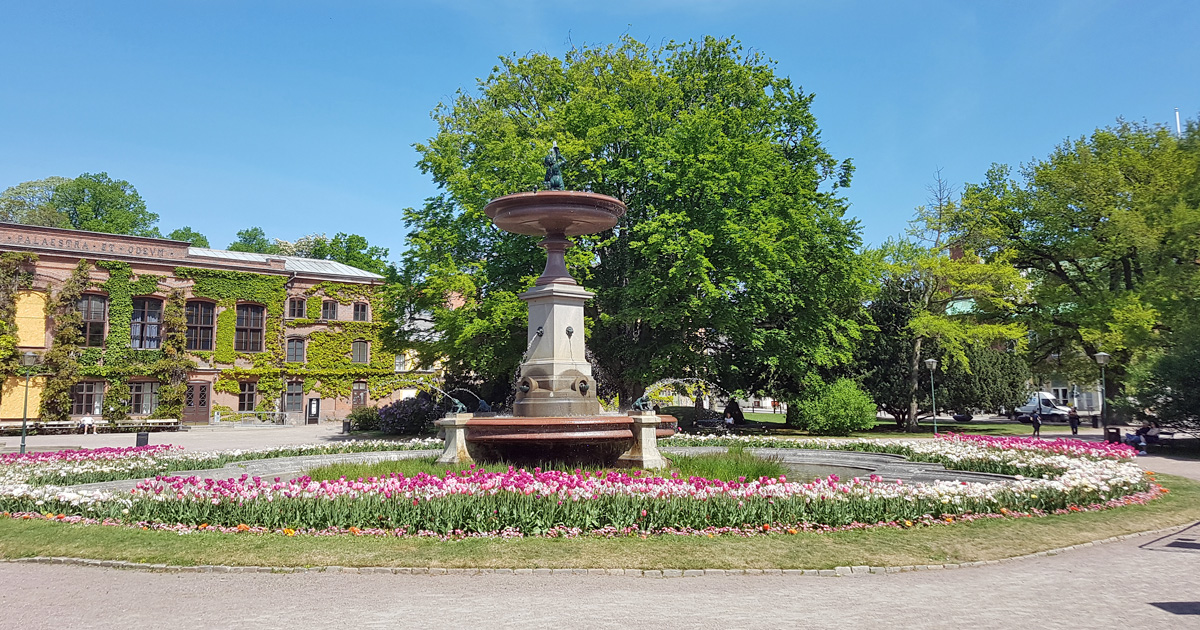 The University Plaza.
The University Plaza.
7) Palaestra et Odeum
Helgo Zettervall also designed Palaestra et Odeum built 1833 as a gym (Palaestra) and a music hall (Odeum) located on the northern side of the Plaza. The gym was destroyed in a fire 1980 and was replaced by a large lecture hall.
 Palaestra et Odeum.
Palaestra et Odeum.
8) The Institution of Anatomy
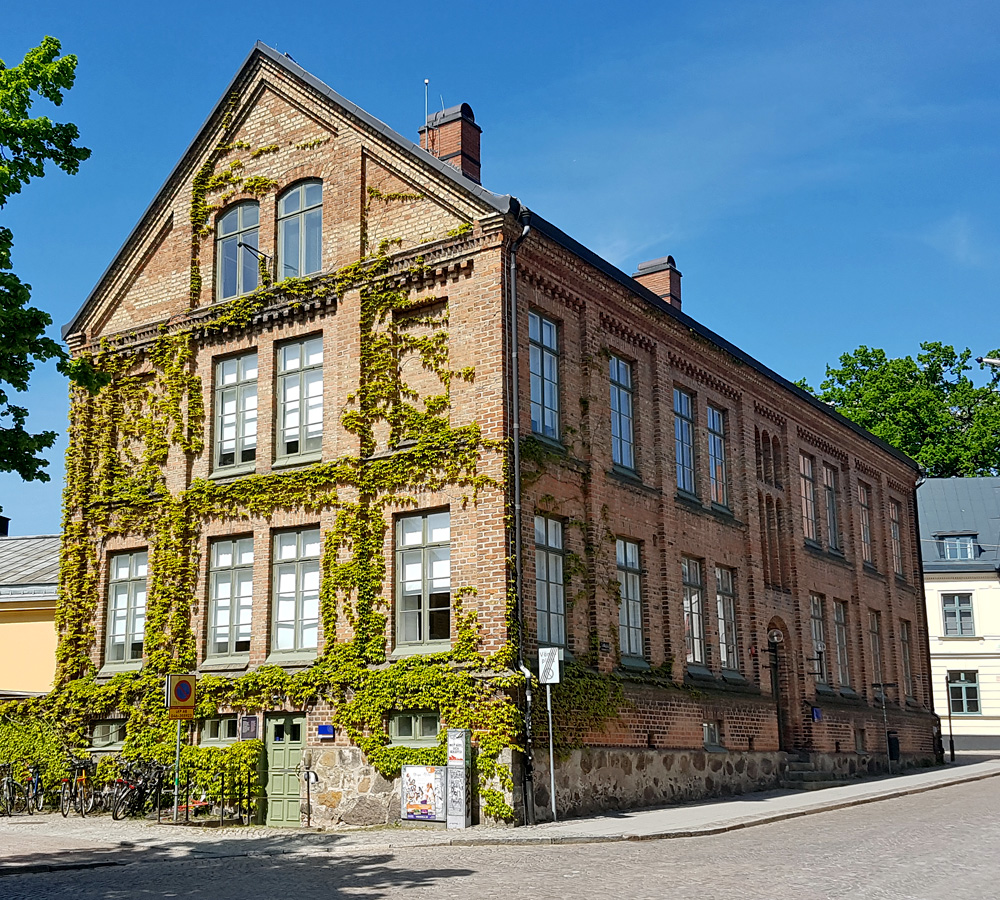 The Institution of Anatomy's building.
There is yet another building at the Plaza, older than both the University Building and
Palaestra et Odeum. It was built 1853 to serve as the new home for the Institution of Anatomy
that needed more space for its growing anatomical collections. It, thus, became the first
institution at the university with a building of its own.
The Institution of Anatomy's building.
There is yet another building at the Plaza, older than both the University Building and
Palaestra et Odeum. It was built 1853 to serve as the new home for the Institution of Anatomy
that needed more space for its growing anatomical collections. It, thus, became the first
institution at the university with a building of its own.
The Institution of Anatomy remained in the building until 1897 when Geology took over. It, in turn, was replaced 1930 by Theology, and later by Archeology.
9) The Academic Society
The Academic Society was founded as an idealistic society December 1st, 1830, on the initiative of Professor Carl Adolph Agardh, and was inagurated with Johan Henrik Thomander as its first Chair. Its formation was a result of the tragic murder of a student during the night of September 8, 1829. The guilty person vas decapitated April 16th, 1830.
The Academic Society’s residence the Sylwan’s Homestead
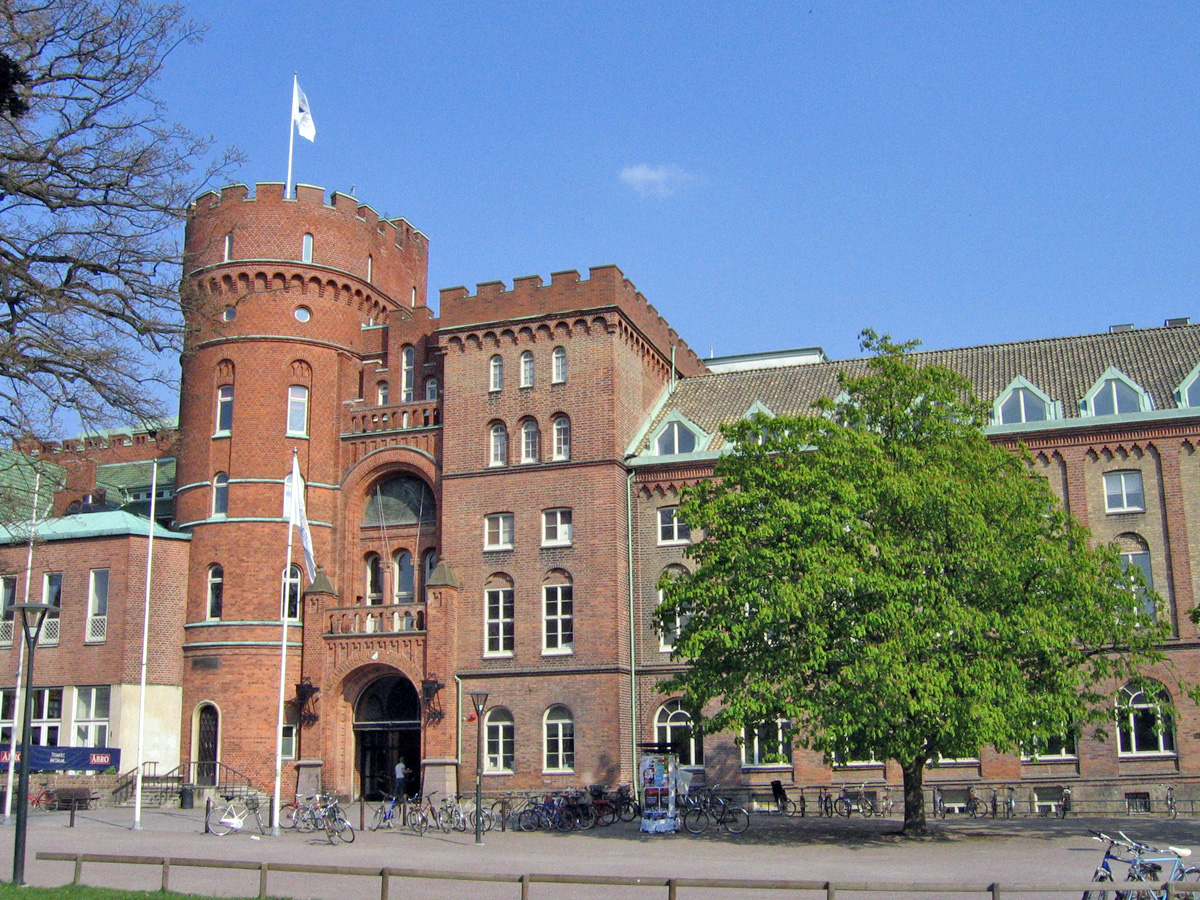 The Academic Society’s large building, the AF Stronghold.
The Academic Society’s large building, the AF Stronghold or the Youth Stronghold, as it is
sometimes called, was built in 1851. AF’s first home was in a building called “Sylwan’s
Homestead,” so named after the merchant Isac Andreas Sylwan, who with his family moved from
Ystad to Lund in 1780. He died November 17th, 1783, and around 1800, his heirs provided for
the construction of the building, now called “Sylwan’s Homestead.” Then, it was located on the
south side of the present AF building, and the property also included the large area around
the present Stronghold.
The Academic Society’s large building, the AF Stronghold.
The Academic Society’s large building, the AF Stronghold or the Youth Stronghold, as it is
sometimes called, was built in 1851. AF’s first home was in a building called “Sylwan’s
Homestead,” so named after the merchant Isac Andreas Sylwan, who with his family moved from
Ystad to Lund in 1780. He died November 17th, 1783, and around 1800, his heirs provided for
the construction of the building, now called “Sylwan’s Homestead.” Then, it was located on the
south side of the present AF building, and the property also included the large area around
the present Stronghold.
The Academic Society’s building the AF Stronghold
The Academic Society bought Sylwan’s Homestead 1830, but it soon became too small for its purpose. Therefore, the AF Stronghold was built. It was inagurated during a three day long celebration, starting May 14th, 1851. Sylwan’s Homestead was sold the same year, and in 1853 it was moved to Råby Street 10 , where it still can be seen. On June 22nd, 1853, the statue of Esaias Tegnér was inagurated. It stands on the south side of AF’s Stronghold, and caused the area to be called Tegnér Plaza. In the beginning, the AF Stronghold was smaller. The round tower and the northern part of the building were built in 1909, including the main entrance.
Atheneum, Convictorium and Societeten
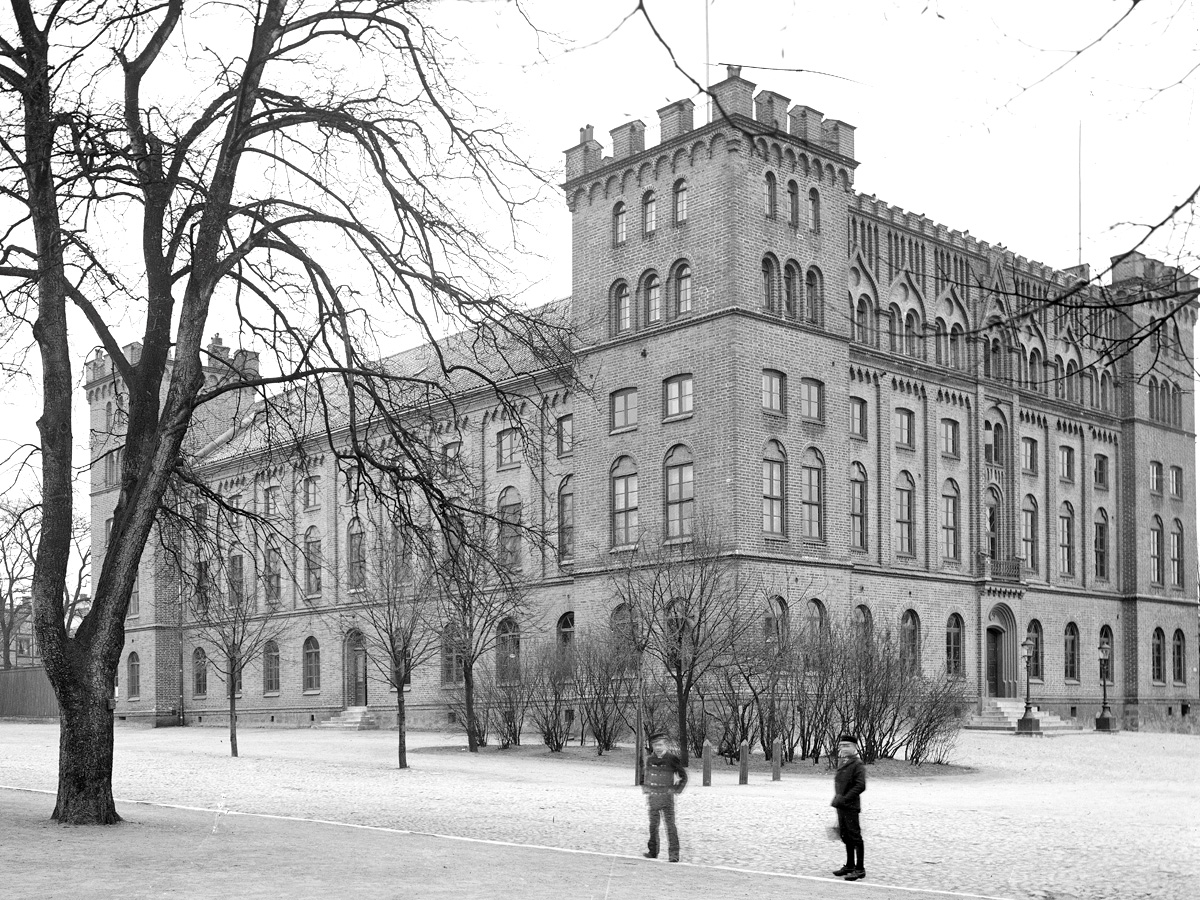 The Academic Society’s building, The AF Stronghold, as it looked like 1851-1909.
The Academic Society was founded with three functions called Atheneum, Convictorium and
Societeten. The purpose of Atheneum was twofold: to function as a reading room that gave
access to both Swedish and foreign newspapers of political and cultural interest and as a
library. The purpose of Convictorium was to offer a modestly priced restaurant as an
alternative to Lund’s many pubs. The purpose of Societeten was to offer social interaction
through lectures, discussions, music, and theater.
The Academic Society’s building, The AF Stronghold, as it looked like 1851-1909.
The Academic Society was founded with three functions called Atheneum, Convictorium and
Societeten. The purpose of Atheneum was twofold: to function as a reading room that gave
access to both Swedish and foreign newspapers of political and cultural interest and as a
library. The purpose of Convictorium was to offer a modestly priced restaurant as an
alternative to Lund’s many pubs. The purpose of Societeten was to offer social interaction
through lectures, discussions, music, and theater.
In the beginning, the interest for social interaction was limited, but it changed when the AF Stronghold was completed with all its many rooms. Since the 1850s, the Stronghold has housed lectures, chorus activities, exhibitions, and active theater performances, including student “spex” (musical parodies).
Atheneum, the Café Athen
Atheneum, or commonly called Athen, soon became a popular and natural gathering place or as it also has been called, the students’ “drawing room.” For a long time, Athen comprised a large room on the ground floor, facing Sand Street, and several smaller rooms. In 1953, however, all the rooms were reconstructed into one large room that covered almost all of the ground floor in the southern part of the house. Previously, one of the smaller rooms was called Café Tua, named for the Italian singer Teresina Tua, who visited Lund several times during the 1880s. She especially enchanted the students at a concert in 1886. In the 1890s, a group of bohemians used to meet in the room. The group was called the Tua-coterie, named for the room, and included a mixture of authors, poets, journalists, and socialists, among others, Axel Wallengren, Bengt Lidforss, Emil Kléen, Axel Danielsson, Paul Rossenius och Adolf Strömstedt.
In the beginning of the 1970s, Athen developed problems, for example, narcotics trade, and, therefore, was closed in 1973. Beginning in the 2000s, however, a large majority of students again wanted a gathering place with a café and space for studies in AF’s Stronghold. Thus, after renovations, the new Café Athen was opened in the fall of 2004.
The University Library at Saints’ Hill.
If you so want, you can end this University historical stroll by visiting the beautiful building of the University Library , one of Lund’s most photographed buildings. It’s a walk of about 400 meters (437 yards) from the AF Stronghold. The library is open to the public. In some reading rooms, however, silence is observed.
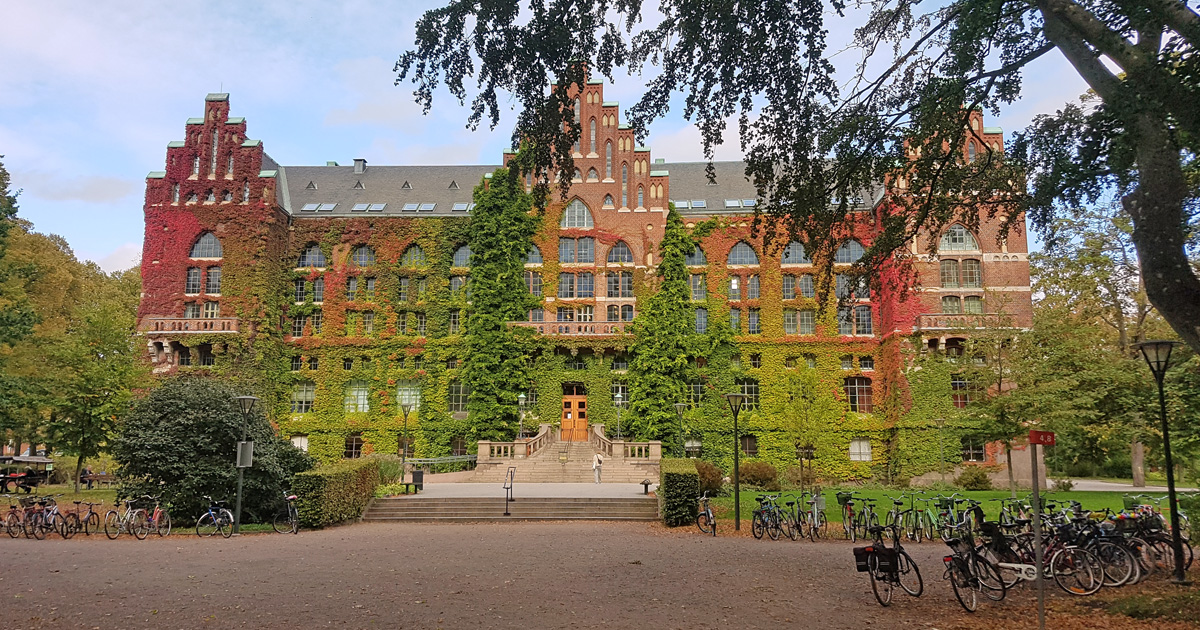 The beautiful building housing the University Library.
The beautiful building housing the University Library.
The University Library was built 1902-1907, to replace the King’s House, which couldn’t hold the increasing number of collections. The new university library was thought to be large enough to last until about 1950. However, already by the beginning of the 1920s, it was filled. Therefore, two additions were built behind the library on its northern side, the first 1933-1936, and the second 1957-1958. Nowadays, Lund’s University Library includes 25 different libraries with almost 130 shelf-km (80+ shelf miles) of manuscripts and printed matter.
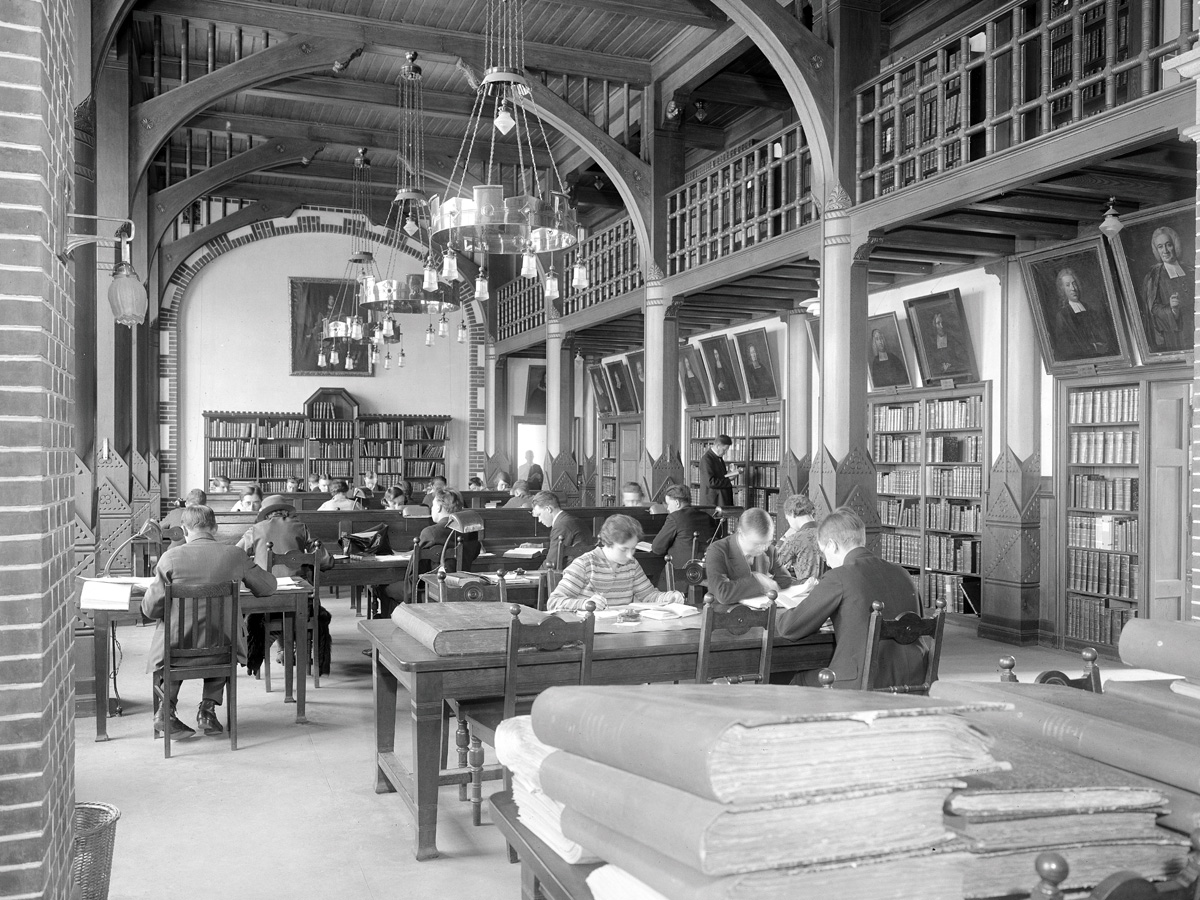 The University Library’s reading room Tegnér Hall, 1929.
Its first floor is of foremost interest for visitors, wanting a look at the University Library. In the entrance, a unique runestone is displayed, the so called Lundagård’s stone that probably was erected around 1000, when Lund was founded as the King’s new city.
The University Library’s reading room Tegnér Hall, 1929.
Its first floor is of foremost interest for visitors, wanting a look at the University Library. In the entrance, a unique runestone is displayed, the so called Lundagård’s stone that probably was erected around 1000, when Lund was founded as the King’s new city.
There are several silent reading rooms, and the oldest and most beautiful of these is the so called Tegnér Hall. The hall has windows inside in order that people may see the hall without disturbing those working on their studies.
Lund’s University Library is a priceless resource for those interested in researching ancestry and native places. The library holds all kinds of literature, and its basement stores all Swedish daily newspapers, available on microfilm. Library cards are also available to those of the public wanting to borrow a book or two.
![[Bild]](/common/img/default.png)